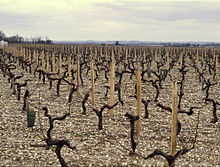Moulis (viticulture)
Moulis in the commune of Moulis-en-Médoc is the smallest of the six communal appellations of the Médoc. In 2002, 27,133 hectoliters of red wine were produced on 607 hectares of cultivation area .
Soil and climate
The Moulis growing area forms a twelve-kilometer-long and up to two-kilometer-wide strip that runs from southwest to northeast. It consists of different geological formations of the Tertiary and Quaternary . Three groups of locations characterize the Moulis growing area:
- The gravel-sand dome of Maucaillou , Grand-Poujeaux and Brillette-Guitignan in the north-east of the area are made of pebbles that the Garonne brought in during the Günz Ice Age . They form the best terroirs for Cabernet Sauvignon due to their rapid heating and excellent drainage .
- The center of the area consists of loamy-calcareous sandy soil. It forms the southern continuation of the Peyrelebade plain in the listrac cultivation area to the north. Mainly Merlot grows here .
- In the southwest, on a partially exposed limestone reef, lie the geologically older peaks of Bouqueyran and Mauvesin , which arose from the Pyrenees rock in the Pliocene . Cabernet is predominantly grown here.
As in the rest of the Médoc, the climate is influenced by the ocean. Due to the greater distance to the Gironde , the river's tempering effect is less than in the neighboring Margaux appellation . Therefore, there is a significant risk of late frost.
Wines and châteaux
The rate of vines depends on the vineyards that the château has. The proportion of Cabernet Sauvignon varies between 45 and 70%, that of Merlot between 25 and 55%. It is remarkable that the otherwise rather rare Petit Verdot often has a share of between 5 and 10%. The Cabernet Franc plays a further supporting role . On the other hand, the Malbec is hardly grown .
The red wine from Moulis is always prepared in the classic Bordeaux style. This includes long maceration and aging in wooden barrels. Typical are proportions of around a third of new barrique barrels . Despite its full body, the moulis is elegant and fine. The plants from the gravel-sand dome show parallels to Margaux and Saint-Julien . Moulis wine is generally less tannic than neighboring Listrac . Therefore, it also develops a little faster in the bottle than that. Depending on the vintage , a Moulis will develop for between 5 and 15 years. The demarcation between Moulis and Listrac is not always clear, because some châteaux also have vines in their neighboring appellation. However, there is a tendency towards separate vinification and marketing.
The majority of Moulis wines belong to the Crus Bourgeois class . The fact that there is no Grand Cru Classé among the Châteaux of Moulis is due to the fact that the municipality was not included in the classification of 1855. Today, however, the wines of the leading goods are on a par with classified plants. Moulis owns a total of 14 Crus Bourgeois, two of which are classified as "Exceptionnel" and seven as "Supérieur":
| Crus Bourgeois exceptionnels | Crus Bourgeois Supérieurs | Crus Bourgeois |
|---|---|---|
|
|
There is no wine cooperative in Moulis, but around ten winegrowers belong to the Cave Coopérative in the neighboring municipality of Listrac. Therefore, several cuvées of the AOC Moulis are produced there.
history
Small-scale viticulture was probably practiced in Moulis as early as Roman times, but the cultivation of grain dominated there until modern times. The name "Moulis" goes back to the numerous wind and water mills that were there. With the systematic development of viticulture in the Médoc from Bordeaux from the 17th century, its importance also steadily increased in Moulis. Viticulture was given a further boost by the construction of the railway line through the Médoc. The Moulis vineyard area had its greatest expansion in 1892, when no less than 1,500 of the 2,000 hectares of communal area were planted. In contrast to the famous communities along the Gironde, viticulture in Moulis was not dominated by large businesses, but by small farmers. At that time there were 200 independent businesses. The wines of the Grand-Poujeaux were famous even then. However, the phylloxera crisis dealt a severe blow to Moulis at the end of the 19th century, from which it only slowly recovered. In 1925 the Syndicat viticole was founded. His efforts to win the wine were finally crowned in 1938 with the recognition of Moulis as a communal appellation. The boom since the Second World War made it possible to invest in vineyards and cellars. The extreme frost of 1956 brought a severe setback. The area under cultivation shrank from 370 hectares in 1955 to 280 hectares in 1962. Since then it has grown steadily until the 1980s. The qualitative progress was honored in 2003 in the new classification of the Crus Bourgeois des Médoc, in which Moulis is prominently represented with two of the nine Crus Bourgeois Exceptionnels .
literature
- Didier Ters: Moulis Listrac . Jacques Legrand, Paris 1987, ISBN 2-905969-04-0
- Jancis Robinson : The Oxford Wine Lexicon . 3. Edition. Gräfe and Unzer Verlag, 2007, ISBN 978-3-8338-0691-9 .
- Pierre Galet : Cépages et Vignobles de France . 1st edition. Lavoisier Publishing House, Paris 2004, ISBN 2-7430-0585-8 .
- Benoît France (ed.): Grand Atlas des Vignobles de France . 1st edition. Solar publishing house, Paris 2002, ISBN 2-263-03242-8 .
